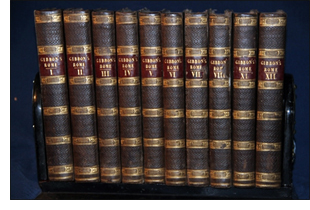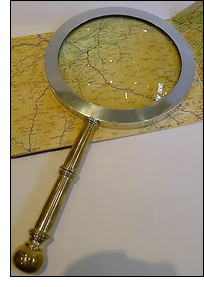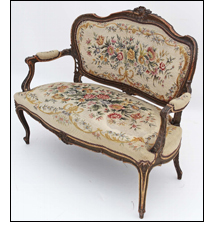featured item
Antiques Magazine Archive, November 2013
Antique Books
 In Edmund Wilson’s American Earthquake he tells us that there is no virtue in first additions. He then goes on to tell the reader of a man who, travelling to work each day, would tear out pages from the book he was reading, because in his opinion there was no further use for them once they’d been read. Wilson would go on to say that although collectors might not be too pleased with such actions “…it is easier for a camel to pass through the eye of a needle than for a collector of first editions to enter the Kingdom of Literature.” His point may have been that although you may love collecting books, that doesn’t necessarily mean you love what’s inside them.
In Edmund Wilson’s American Earthquake he tells us that there is no virtue in first additions. He then goes on to tell the reader of a man who, travelling to work each day, would tear out pages from the book he was reading, because in his opinion there was no further use for them once they’d been read. Wilson would go on to say that although collectors might not be too pleased with such actions “…it is easier for a camel to pass through the eye of a needle than for a collector of first editions to enter the Kingdom of Literature.” His point may have been that although you may love collecting books, that doesn’t necessarily mean you love what’s inside them.
There may be many amongst you that feel this is quite a preposterous notion, especially those of you who are avid readers and collectors of rare and fine books. Reading is special and no amount of kindles or ipads can take their place, but reading and collecting books can be two entirely different things. A collection of rare books is hardly likely to be taken down from a shelf and lovingly read for fear of damaging it irreparably, after all, a single first edition could be worth thousands, it can hardly be flicked through casually of an evening, while watching TV. Such books demand great care and attention. We have already covered book cases in an earlier blog and there are some fine furniture pieces out there for those of you who do collect, today however, we are looking at the books themselves.
Antique Maps
 Karl Jennings the famous American game show host once said that even before you understood them, your brain was drawn to maps. Maps are fascinating pieces of information, especially old ones, giving a unique glimpse of the land we know now as it once was.
Karl Jennings the famous American game show host once said that even before you understood them, your brain was drawn to maps. Maps are fascinating pieces of information, especially old ones, giving a unique glimpse of the land we know now as it once was.
Maps go back a long way, 5,000 years in fact to the time when they were far more simple affairs, showing the most important aspects of an area such as a city, a trade route or a military campaign. Unlike later maps they did not have the same intricate structure, there was no north sign at the top and they weren’t always accurate, showing denser features of land at the centre and less at the edges.
Old maps were more like iconographic images of land than accurate references to parts of the landscape. They were to be admired rather than taken seriously, as you were unlikely to find where you needed to go by following a map. They were usually made by hand and were very expensive to make and were admired for their artistry rather than their accuracy.
Antique Sofas
 Antique Sofas. Who hasn’t hankered after a chaise longue to languish on of an evening? To lie dramatically in its plush velvet coverings and collapse on to it like an exhausted Countess. The chaise longue is a fine and elegant piece of furniture, it’s a bed, it’s a sofa, it’s a chair. It combines shapes and colours beautifully, which makes for a graceful and curvaceous piece of luxury.
Antique Sofas. Who hasn’t hankered after a chaise longue to languish on of an evening? To lie dramatically in its plush velvet coverings and collapse on to it like an exhausted Countess. The chaise longue is a fine and elegant piece of furniture, it’s a bed, it’s a sofa, it’s a chair. It combines shapes and colours beautifully, which makes for a graceful and curvaceous piece of luxury.
The chaise longue comes from the French for ‘long chair,’ and it was a popular piece of furniture during the Rococo period where it first made its appearance. During this time, in the 18th century the Rococo period had great influence on all aspects of the arts including sculpture, painting, music, writing and interior design. The Rococo style itself developed in the early 18th century in response to the grand yet conservative Baroque period. While Baroque was grand Rococo was flamboyant, creating elegant and ornate pieces with furniture playing its part, taking on the dynamics of Rococo style with a vengeance.
Todays Daily Telegraph
 “We have more than 120,000 items for sale,” says Iain Brunt, who founded antiques.co.uk 10 years ago. “I am trying to protect the knowledge of the dealer,” he says. “They’ve done the work, it is their passion. A lot of them have struggled recently. The site gives them a place to list their details, and also to sell things directly. We try to ensure there aren’t fakes, or nasty things like Nazi memorabilia that can sometimes crop up . Members of the public are fantastic for spotting when things are wrong.” He estimates that online now accounts for 10-15 per cent of antiques sales, and is increasing. “It’s bigger in America,” he says. “In England you are only around the corner from your nearest shop, whereas in the US you might be two hours’ flight away. But online listings are getting better all the time.”
“We have more than 120,000 items for sale,” says Iain Brunt, who founded antiques.co.uk 10 years ago. “I am trying to protect the knowledge of the dealer,” he says. “They’ve done the work, it is their passion. A lot of them have struggled recently. The site gives them a place to list their details, and also to sell things directly. We try to ensure there aren’t fakes, or nasty things like Nazi memorabilia that can sometimes crop up . Members of the public are fantastic for spotting when things are wrong.” He estimates that online now accounts for 10-15 per cent of antiques sales, and is increasing. “It’s bigger in America,” he says. “In England you are only around the corner from your nearest shop, whereas in the US you might be two hours’ flight away. But online listings are getting better all the time.”




